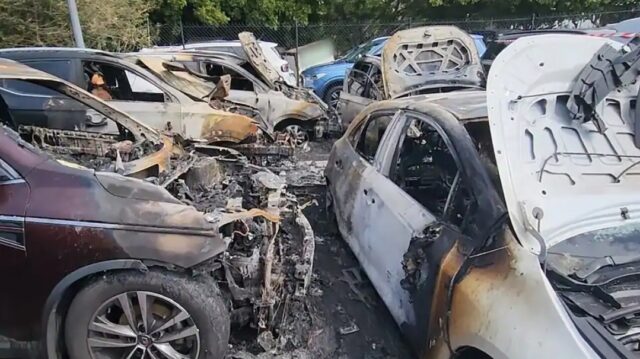As lithium-ion batteries become prevalent in electric vehicles and homes, fires started by them are also becoming more common.
Fire ripped through five cars parked at Sydney Airport after a lithium-ion battery ignited on Tuesday.
Video of the aftermath showed the burnt-out battery casing from a luxury electric vehicle surrounded by the charred remains of several cars.
Fire and Rescue NSW (FRNSW) has responded to 114 Lithium-ion battery fires from 1 January-31 July 2023, not including car-battery fires.
This is trending upwards, with 165 recorded across all of 2022.
The most common type of battery fires reported were related to battery power supplies and e-bikes, scooters and ride-on toys.
How do lithium-ion batteries work?
In simple terms, lithium-ion batteries work by pulling electrodes from one end to the other to generate energy, University of Wollongong associate professor Wei Kong Pang told SBS News.
“We can pick up pieces of energy storage, that can store electricity in chemical form, and when we charge the battery, we move the lithium-ion from the positive side to the negative side,” he said.
During the lithium-ion moving around positive and negative electrodes, there is some “thermal runaway” or escaped heat generated, which is unavoidable, he said.
Every time a battery charges, it generates heat – think of your phone feeling warm after you unplug it.
How do lithium battery fires start?
“The heat is not really serious in terms of the battery’s danger or safety,” Pang said, but if the battery has any defects or problems, the heat becomes a risk factor for generating a fire.
“If the battery has some short-circuiting, which means when the positive side and negative side connect together for some reason, it will generate a lot more heat because a lot of currents flow in between the electrons.”
Overcharging a battery can cause short-circuiting and damage to the battery.
Physical damage to the battery makes the heat more unstable and increases the fire risk.
The chemical fires produce toxic gases and are hard to extinguish.
In theory, the larger the battery, the hotter it can get and the more at risk it is, Pang said.
“When the site is getting larger and larger and is confined in a box and the heat will accommodate, so that’s why the fire will be generated.”
But though they are much larger, lithium-ion car batteries are held to much higher manufacturing standards than e-bike or scooter batteries and are considered safer.
How to avoid lithium battery fires
FRNSW says one of the first things to do is make sure you are only using batteries and chargers from reputable brands and sources and encouraged people to do research.
It pointed out that using chargers with the wrong voltage will damage the battery and could cause a fire.
People should never store or leave batteries and devices in areas where they can be exposed to heat or moisture, according to the organisation.
It says not to leave devices such as phones, computers or charging devices in direct sunlight or in parked vehicles where they can quickly heat up.
Lithium-ion batteries are mostly imported to Australia from Europe and Asia, meaning Australia has little control over regulation of quality control and enforcing standards, Pang said.
So if more batteries were produced in Australia, it would be possible to enforce stronger regulations.
Battery management systems are improving all the time, which is positive for safety, Pang said.
When the batteries get too hot, a cooling system kicks in to drop the temperature down and decrease the risk of explosion.
Pang said scientists hope “solid state” batteries which are much safer, will become more prevalent in the future.



































